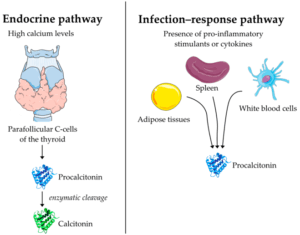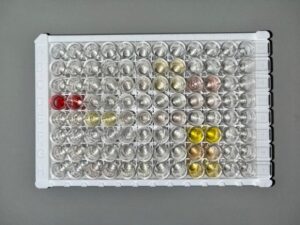Serum procalcitonin as a marker of infectious causes of systemic inflammatory response syndrome in domestic cats
12 June 2025
Dr Tim Williams and final year University of Cambridge veterinary student Tarn Chamberlain James received funding for a student research project exploring the utility of serum procalcitonin concentrations in diagnosing systemic inflammatory response syndrome (SIRS) aetiology in domestic cats. The project was carried out in Tarn’s final year at the University of Cambridge Veterinary School (2023-24), and she describes her work here.
Why was this research important?
The rise of antimicrobial resistance is of global concern. During a journal club discussing antimicrobial protocols in reptiles, I realised that a lot of inappropriate antimicrobial use is due to presumed bacterial aetiology based on professional judgement. This could be avoided if biomarkers existed that could differentiate between bacterial and other causes of inflammation. The use of such a biomarker would also be more rapid than bacterial culture, allowing earlier administration of antimicrobials in patients that need them.
SIRS is a major cause of fatality in veterinary species, with early recognition and intervention important for improving patient survival. The diagnosis of SIRS, particularly in cats, is challenging since the presenting signs are often non-specific, and it is currently based on the fulfilment of at least three of four SIRS criteria.
Procalcitonin (PCT) is the precursor to the hormone calcitonin. In healthy individuals, PCT is produced from the parafollicular cells of the thyroid and converted to calcitonin in response to increased circulating calcium concentrations. Normal PCT levels are typically below the detectable threshold of clinical assays (<10 ng/ml) due to its rapid conversion to calcitonin. However, PCT concentrations are increased in response to a pro-inflammatory stimulus and released from extra-thyroidal sources such as neutrophils, monocytes, the liver and spleen (Figure 1). Serum PCT concentrations are therefore a promising biomarker of bacterial SIRS in humans.

Figure 1. Endocrine and infectious-response pathways of procalcitonin.
Very few studies have investigated PCT in cats with SIRS. One study (Matur et al. 2022) found PCT to be effective in differentiating bacterial and viral causes of feline infection, but no work had been done to evaluate its utility in differentiating infectious from non-infectious causes of SIRS in cats. Therefore, we aimed to determine if PCT is a more reliable biomarker for predicting an infectious cause of SIRS in cats compared to currently used inflammatory markers such as serum amyloid A (SAA) and blood neutrophil count.
Since PCT increases in response to bacterial infection and SAA is a non-specific acute phase protein, PCT was expected to be superior in identifying infectious causes of SIRS compared with SAA.
What did our research discover?
Thirty-three feline serum samples had been stored at the Queen’s Veterinary School Hospital. Nine of these were from cats diagnosed with SIRS using standard criteria, which were further divided into those with infectious (n=3) and non-infectious (n=4) aetiologies; two cats had an undetermined aetiology and were excluded from further analysis. The remaining 24 samples were from healthy controls. PCT concentrations were measured using a commercially available procalcitonin ELISA kit (MyBioSource MBS073354). A 500 pg/ml standard solution was prepared, from which serial dilutions (500 pg/ml to 0 pg/ml) were created. Inter- and intra-assay variability were assessed using aliquots of sample serum, and all reagents were brought to room temperature prior to the assay. Standards and serum samples were placed in duplicate wells, followed by the addition of anti-PCT antibody and streptavidin-HRP, then mixtures were incubated at 37°C (Figure 2). The wells were washed multiple times before adding substrate solutions A and B, incubating for 10 minutes in the dark, and stopping the reaction. Optical density (OD) values were recorded at 450 nm, and standard curves were generated using the OD values to allow the calculation of sample PCT concentrations.

Figure 2. ELISA plate with serum samples, anti-PCT antibody and streptavidin-HRP.
Although serum PCT concentrations were higher in the SIRS group compared to the control group, serum PCT concentrations were not significantly different between cats with infectious and non-infectious causes of SIRS. However, serum SAA concentrations were significantly higher in cats with infectious causes of SIRS compared to those with non-infectious causes (P=0.022). Therefore, serum PCT concentrations may not be a clinically useful parameter for differentiating infectious from non-infectious causes of SIRS in cats.
PCT and SAA are both inflammatory biomarkers, so it is unsurprising that both biomarkers are raised in the SIRS group compared to the control group. These results have certainly advanced our knowledge of PCT and laid the groundwork for more exploration of PCT as a biomarker for SIRS in cats.
About the author
Supporting more BSAVA PetSavers research


